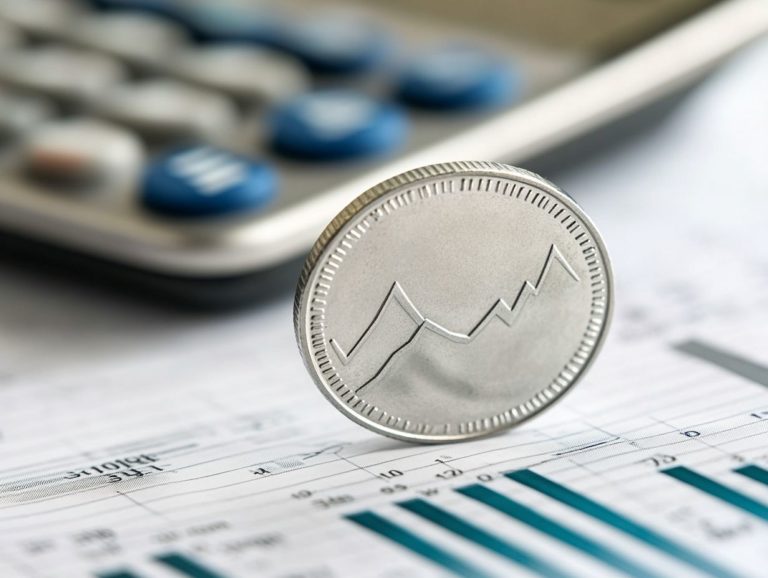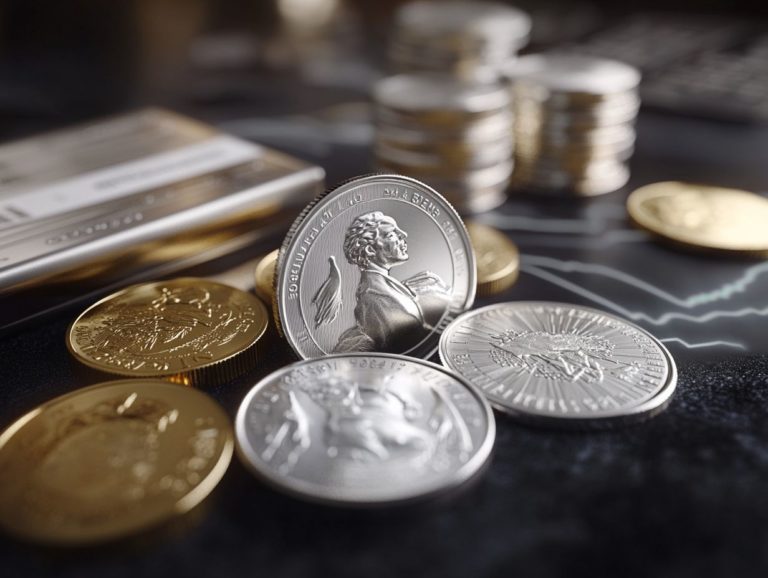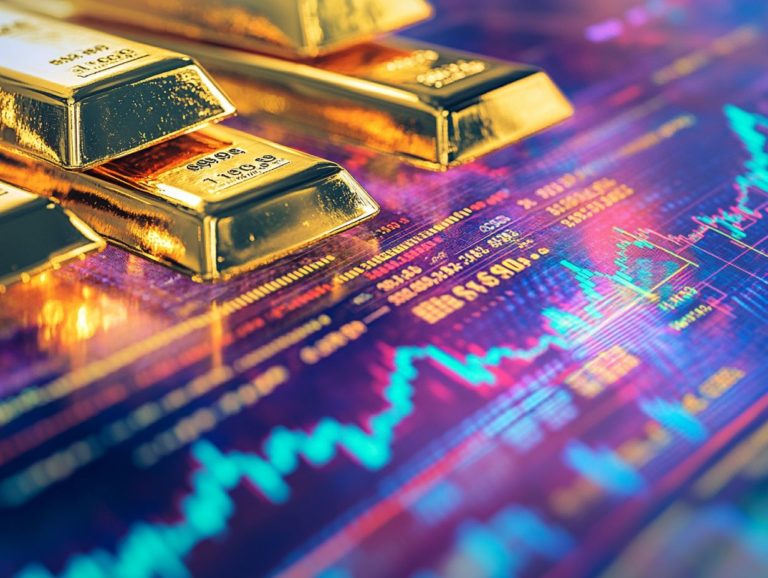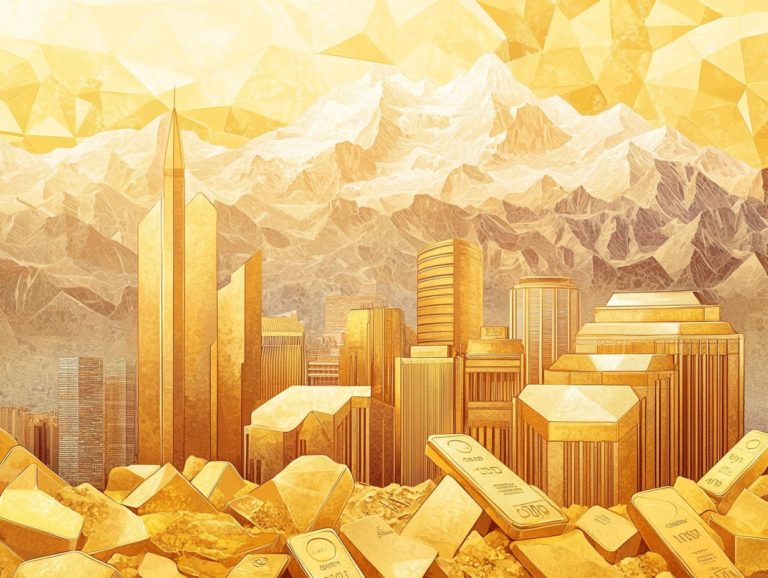Palladium Price Trends: An Investor’s Perspective
Palladium is a precious metal renowned for its significance in the automotive and electronics sectors. It has garnered considerable interest from investors across the globe.
For anyone contemplating an investment in this volatile market, grasping the factors that sway its prices is essential.
This article delves into the intricate dynamics influencing palladium prices. We ll outline both the advantages and risks of investing, analyze historical trends, and offer predictions for what lies ahead.
Uncover effective strategies designed to maximize your investment returns while minimizing risks. Equip yourself with insights that will empower your decisions in the realm of palladium investment.
Contents
- Key Takeaways:
- Understanding Palladium Prices
- Investing in Palladium
- Strategies for Investing in Palladium
- Historical Trends of Palladium Prices
- Predictions for Future Palladium Prices
- Frequently Asked Questions
- What is Palladium and Why is It Important for Investors?
- What Has Been the Recent Trend in Palladium Prices?
- Are There Any Factors That Can Affect Palladium Prices?
- Is Palladium a Good Long-Term Investment?
- How Can Investors Track Palladium Prices?
- Is It Possible to Invest in Palladium Without Physically Owning the Metal?
Key Takeaways:
- Palladium prices fluctuate due to supply and demand.
- Investing in palladium can diversify your portfolio but comes with risks.
- Expert forecasts indicate a bright future for palladium due to rising demand.
Understanding Palladium Prices
Understanding palladium prices is essential for investors. Its role in the precious metals market is distinctive.
This market is heavily influenced by demand dynamics, supply fluctuations, and external factors like political issues between countries, particularly those involving Russia and South Africa.
As the automotive industry increasingly depends on palladium for emissions control, the energy transition significantly impacts price trends and market insights. The rise of electric vehicles complicates the investment landscape.
It’s vital to analyze historical pricing alongside current demand to navigate this evolving landscape.
Factors Affecting Palladium Prices
Several factors influence palladium prices, with supply and demand serving as the primary forces in this volatile market. Economic growth, production challenges in mining operations, and strategic maneuvers of central banks contribute to the ebb and flow of these prices.
Significant disruptions in mining activities in South Africa and Russia have raised concerns about the stability of palladium supply. This has led to price fluctuations that resonate throughout the global market.
As automotive manufacturers shift their focus toward electric vehicles, the demand for palladium essential for emissions control has changed significantly. This highlights the delicate balance of market dynamics, where geopolitical tensions and environmental policies play crucial roles in shaping how palladium prices evolve over time.
Investing in Palladium
Investing in palladium offers unique opportunities and challenges. On one hand, you could benefit from price appreciation and strong returns. On the other, you must navigate risks like volatility and market unpredictability.
This landscape demands well-informed investment strategies, tailored for both financial institutions and individual investors.
Benefits and Risks of Investing in Palladium
Investing in palladium presents you with a range of advantages, including exposure to a precious metal that enjoys significant industrial demand, particularly from the automotive sector.
However, it’s essential to acknowledge the risks involved, such as price volatility and geopolitical uncertainties that can influence overall market stability.
The unique properties of palladium make it essential for emissions control, ensuring consistent demand. As economies expand especially in emerging markets with stricter environmental regulations palladium’s essential role may lead to substantial price appreciation.
As a potential investor, remain aware of the turbulence often triggered by fluctuations in the global economy and the decisions made by central banks. These factors can dramatically impact market stability and the overall investment climate, so staying informed is key to navigating this landscape successfully.
Strategies for Investing in Palladium
To develop effective strategies for investing in palladium, you need to grasp the market dynamics fully. This involves assessing potential risks and pinpointing opportunities that can enhance profits while minimizing your exposure to volatility.
Given the current economic trends and geopolitical factors at play, a well-informed approach is essential for navigating this complex landscape successfully.
Tips for Maximizing Profits and Minimizing Risks
To maximize profits and minimize risks in your palladium investments, consider employing a diverse range of strategies. This includes conducting thorough market analysis, grasping the intricacies of supply-demand dynamics, and staying informed about geopolitical developments that could impact prices.
Dive into historical price trends and utilize technical analysis tools to identify potential entry and exit points. Emphasizing risk assessment is essential; evaluate your portfolio s exposure to palladium and think about using stop-loss orders orders that automatically sell your asset when it reaches a certain price to limit losses.
Maintain a sharp awareness of regulatory changes and economic indicators such as the growth of the auto industry or shifts in renewable energy policies this can provide you with invaluable insights. Stay connected with industry news sources and participate in investment forums to further enhance your understanding and refine your strategy.
Historical Trends of Palladium Prices
When you analyze the historical trends of palladium prices, you’ll uncover significant fluctuations shaped by intricate market dynamics. These include shifts in supply and demand, events related to politics between countries, and the ever-evolving automotive industry, especially as it relates to catalytic converters and emission standards.
Together, these factors intricately weave the overall price landscape over the years, revealing a complex narrative that reflects the broader economic environment.
Analysis of Past Price Fluctuations
Analyzing past price fluctuations in palladium reveals how external factors like production challenges in key mining countries and shifts in demand from the automotive sector have resulted in both surpluses and deficits in the market.
These fluctuations are often intensified by geopolitical tensions, trade policies, and the rapid evolution of vehicle technology, all of which significantly influence the demand for catalytic converters that rely on palladium. For example, when South African mines encounter operational difficulties, global supply becomes constrained, causing prices to surge sharply.
On the flip side, advancements in technology that encourage the use of alternative materials can sometimes create a temporary oversupply, which depresses prices.
As an investor, grasping these market dynamics can give you an edge!
Predictions for Future Palladium Prices
Predictions regarding future palladium prices captivate both investors and analysts. Expert forecasts indicate that you can expect ongoing volatility, shaped by various market conditions, the energy transition toward electric vehicles, and the sustained demand from the automotive sector for catalytic converters.
Expert Forecasts and Market Projections
Expert forecasts and market projections for palladium suggest that while you may encounter periods of volatility, the metal’s vital role in the automotive industry, along with its potential for growth in other sectors, presents attractive investment opportunities.
As the demand for cleaner emissions escalates driven by the shift toward electric vehicles and increasingly stringent environmental regulations many analysts contend that palladium will continue to play a pivotal role in this evolving landscape.
Geopolitical factors, supply chain disruptions, and mining challenges can significantly sway market dynamics, adding layers of complexity to price movements. Consider these influences, especially as alternative catalysts and recycling initiatives come to the forefront, potentially reshaping the demand landscape for this precious metal.
By keeping yourself informed about these trends, you can navigate potential investment scenarios more effectively in the often volatile palladium market.
Frequently Asked Questions
Here are some common questions about investing in palladium to help guide your strategy.
What is Palladium and Why is It Important for Investors?
Palladium is a precious metal primarily used in the automotive industry for catalytic converters, which reduce harmful emissions. It is also utilized in electronics and jewelry.
As demand for palladium increases, its price tends to rise, making it a potentially profitable investment for investors.
What Has Been the Recent Trend in Palladium Prices?
Recently, palladium prices have steadily increased, reaching an all-time high of over $2,800 per ounce in 2020.
This surge is driven by rising demand from the automotive sector and a limited supply of the metal.
Are There Any Factors That Can Affect Palladium Prices?
Yes, several factors can impact palladium prices, including economic conditions, supply and demand dynamics, geopolitical events, and currency fluctuations.
Staying updated is crucial for any investor looking to seize opportunities in the palladium market.
Is Palladium a Good Long-Term Investment?
While past performance does not guarantee future results, many experts believe that palladium has strong long-term potential.
This belief is due to its various industrial uses and limited availability. However, as with any investment, there is always a level of risk involved.
How Can Investors Track Palladium Prices?
You can easily track palladium prices through financial news outlets and specialized websites that provide real-time updates on commodity prices.
Don’t hesitate to consult a financial advisor for tailored advice on your investments.
Is It Possible to Invest in Palladium Without Physically Owning the Metal?
Yes, there are various ways to invest in palladium without owning the physical metal.
Options include palladium mining stocks, exchange-traded funds (ETFs), and futures contracts. These alternatives allow investors to gain exposure to the palladium market without the need for physical storage or delivery.
Start monitoring palladium prices today to capitalize on this exciting investment opportunity!















